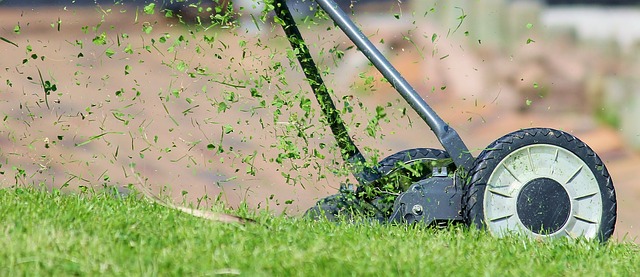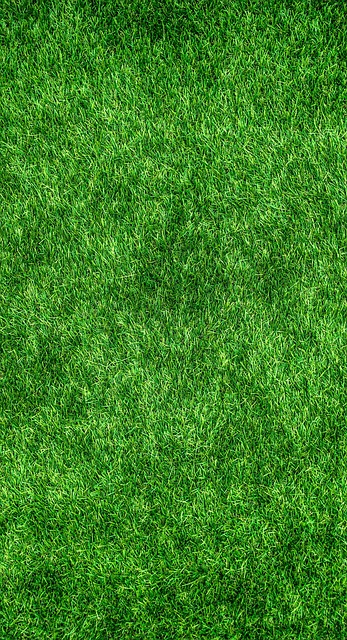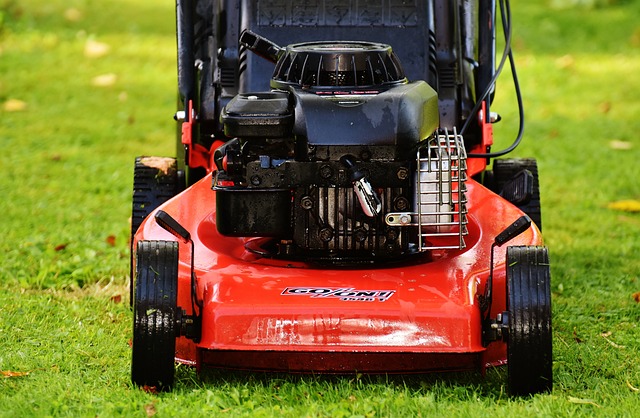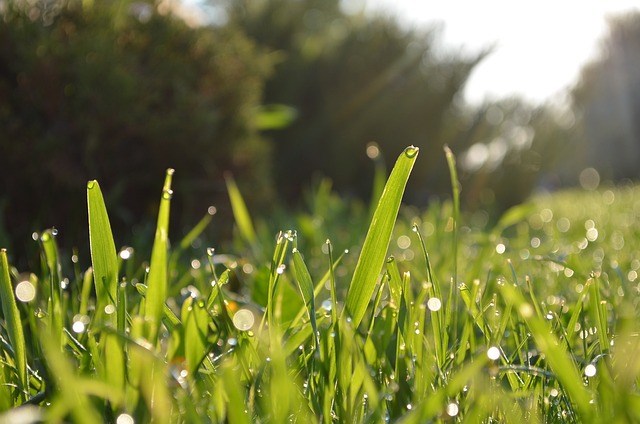Regular lawn mowing at the right height and frequency promotes a healthy, dense turf that naturally resists weed encroachment and thrives in local climates. A consistent mowing routine not only enhances the lawn's appearance but also its root system's strength, making it more resilient to pests, diseases, and environmental stressors. This regimen allows for early detection of potential issues, enabling prompt treatment. Strategic fertilization with essential nutrients supports robust grass growth and overall soil health, aiding the lawn in coping with various challenges. Aeration is crucial for relieving soil compaction, which improves the flow of water, oxygen, and nutrients to the roots. Together, these practices—tailored to your lawn's specific needs, whether it's a cool-season or warm-season grass—ensure a lush, green, and resilient outdoor space year-round. Professional lawn care services with expert knowledge can customize mowing, fertilizing, and aeration schedules to maintain a thriving lawn that is both visually appealing and ecologically sustainable.
Lawns are more than just expanses of green; they’re a canvas of natural beauty that can elevate the aesthetic of any property. A well-maintained lawn not only enhances curb appeal but also supports ecosystem health and provides a serene outdoor space for relaxation and play. This article delves into the pivotal practices of lawn mowing, fertilizing, and aeration, which are integral to maintaining a thriving yard. We’ll explore the benefits of regular mowing, the science behind strategic fertilization, and the often-overlooked importance of aeration services. By understanding and implementing these key lawn care strategies, you can ensure your grass remains lush, dense, and vibrant throughout the seasons.
- Understanding the Importance of Regular Lawn Mowing for a Thriving Yard
- The Role of Strategic Fertilization in Nourishing Your Lawn's Health
- Aeration Services Explained: Why It's Crucial for Your Lawn's Oxygen and Nutrient Uptake
- Combining Mowing, Fertilizing, and Aeration for a Lush and Vibrant Lawn
- Choosing the Right Lawn Mowing, Fertilizing, and Aeration Services for Your Lawn's Needs
Understanding the Importance of Regular Lawn Mowing for a Thriving Yard

Regular lawn mowing plays a pivotal role in maintaining a healthy and aesthetically pleasing yard. Consistently trimming grass at the correct height not only encourages lush growth but also deters weeds from taking over, ensuring your lawn remains dominant and vibrant. The frequency of mowing can vary depending on local climate conditions and grass type; typically, a well-maintained lawn requires cutting every week to two weeks during active growing seasons. This practice stimulates root growth, as the removal of upper leaves forces the grass to focus on root development to recover, leading to a more robust and resilient lawn. Moreover, regular mowing helps in shaping the turf, giving it a uniform appearance that is pleasing to the eye and inviting for outdoor activities.
In addition to maintaining a neat and orderly landscape, frequent lawn mowing contributes to the prevention of thatch accumulation, which can suffocate grass roots if left unchecked. A well-maintained lawn also signals pests and diseases to stay away, as overgrown or neglected turf is more susceptible to such issues. Furthermore, the act of mowing regularly ensures that you can better monitor the health of your lawn, allowing for early detection and treatment of any problems that may arise, thus preserving its vitality throughout the seasons.
The Role of Strategic Fertilization in Nourishing Your Lawn's Health

A robust lawn care regimen is anchored by strategic fertilization, an essential practice for nourishing your lawn’s health and fostering a lush, vibrant turf. Fertilizers supply the necessary nutrients that grass lacks, particularly nitrogen, phosphorus, and potassium, which are crucial for leaf growth, root development, and overall plant health. Timely application of these nutrients ensures your lawn can withstand environmental stressors, recover from wear and tear, and maintain a dense sward to outcompete weeds. To maximize benefits, it’s important to tailor the type and timing of fertilization to local climate conditions and grass types; this tailored approach optimizes nutrient uptake and minimizes environmental impact.
Understanding the lawn’s growth patterns and environmental factors allows for a precise fertilization schedule that aligns with the lawn’s nutritional needs throughout the growing season. For instance, cool-season grasses thrive on fertilization in the early fall and late spring, while warm-season grasses are best fed in late spring through summer. This targeted approach to fertilization not only enhances lawn health but also contributes to a sustainable and environmentally friendly landscape. By integrating fertilization into a comprehensive lawn care program that includes mowing and aeration, homeowners can ensure their lawns receive the balanced nutrition they need for optimal growth and resilience.
Aeration Services Explained: Why It's Crucial for Your Lawn's Oxygen and Nutrient Uptake

Aeration services are a vital aspect of lawn maintenance, offering significant benefits for your turf’s health and vigor. This process involves the mechanical removal of soil cores or plugs from your lawn to alleviate soil compaction. Compacted soils hinder the movement of water, oxygen, and nutrients into the roots, which can lead to a weakened and less resilient lawn. By creating thousands of small holes, aeration enables these essential elements to reach the root zone more effectively. This not only promotes a stronger root system but also contributes to a healthier lawn overall. Aeration is typically most effective when combined with proper fertilization practices, ensuring that nutrients are delivered directly where they can do the most good. The result is a more robust and lush lawn capable of withstanding foot traffic, resisting diseases, and thriving in various climates.
Regular aeration, when timed correctly, can significantly improve your lawn’s ability to absorb fertilizers. After aerating, the open channels in the soil allow for better nutrient uptake, making any fertilization application more efficient and effective. This is because the nutrients have a clearer pathway to the roots, which can lead to a greener, thicker lawn. Professional aeration services ensure that this process is done correctly, targeting the areas of your lawn most in need of improvement, and scheduling treatments at optimal times throughout the year to maximize benefits. By understanding the science behind soil compaction and root health, these services help you make informed decisions about your lawn care regimen, leading to a landscape that not only looks its best but also has the resilience to endure various environmental challenges.
Combining Mowing, Fertilizing, and Aeration for a Lush and Vibrant Lawn

Regularly maintaining your lawn through mowing, fertilizing, and aeration is a trifecta approach that promotes a lush and vibrant lawn. Mowing at the correct height and frequency allows grass to grow stronger and more resilient, ensuring it can effectively absorb nutrients from fertilization. The choice of fertilizer, enriched with essential macro and micronutrients, supports diverse grass species and aids in root development for a robust lawn structure. Aeration, performed periodically to alleviate soil compaction, creates pathways for water and oxygen to reach the roots, further enhancing the health of your turf. Combining these practices not only improves soil health but also contributes to a lush carpet of grass that can withstand varying environmental conditions, ensuring your lawn remains verdant throughout the seasons.
The synergy between mowing, fertilizing, and aeration is crucial for maintaining a balanced and thriving lawn ecosystem. Mowing keeps the lawn trimmed and tidy, preventing any one area from becoming overgrown, which can lead to disease and pest issues. Fertilizing supplements what the soil may lack, providing a buffet of nutrients that encourages strong growth and root development. Aeration complements these efforts by allowing water and air to penetrate the soil more deeply, promoting better root growth and overall lawn health. Lawn care professionals can tailor a regimen that includes the right mowing height and pattern, the most effective fertilizing schedule, and the optimal timing for aeration to ensure your lawn receives the best possible care. Employing these services regularly not only enhances the visual appeal of your outdoor space but also supports a healthy and sustainable environment.
Choosing the Right Lawn Mowing, Fertilizing, and Aeration Services for Your Lawn's Needs

When selecting lawn mowing, fertilizing, and aeration services, it’s crucial to consider the specific type of grass and local soil conditions of your lawn. Different grass varieties have distinct mowing heights and nutritional requirements. For instance, cool-season grasses like Kentucky bluegrass thrive with frequent, slightly higher mows, while warm-season grasses like Bermuda grass require less frequent but lower cuts to flourish. A professional service will tailor their approach based on your lawn’s composition, ensuring a healthy, vibrant turf.
Fertilizing and aeration are equally vital for maintaining a lush lawn. The right fertilizer not only feeds the grass but also supports soil health and beneficial microorganisms. Aeration, on the other hand, helps alleviate soil compaction, allowing nutrients, air, and water to penetrate the root zone more effectively. This process stimulates root growth, leading to a thicker, more resilient lawn that can better withstand foot traffic and environmental stressors. Opting for services that employ a holistic approach, considering your lawn’s unique needs, will yield the best results. Lawn care professionals equipped with the latest knowledge and tools can diagnose and address your lawn’s specific issues effectively, ensuring optimal growth and appearance.
Effective lawn maintenance is key to achieving a healthy and attractive yard. This article has outlined the critical practices of regular mowing, strategic fertilization, and aeration, emphasizing their individual and combined benefits for your lawn’s vitality. By understanding how each service contributes to your lawn’s health—from promoting optimal growth through mowing to enhancing nutrient absorption and root development via fertilizing and aerating—you can make informed decisions about the care of your outdoor space. To maintain a lush, vibrant lawn, consider enlisting professional services tailored to your specific grass type and local climate conditions. With the right approach and maintenance schedule, your lawn will not only thrive but also serve as a welcoming green haven for you and your community.
